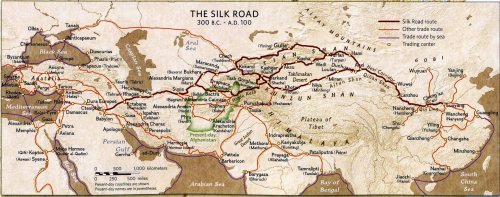Gan Ying, a Chinese explorer in Ancient RomeAs some of this blog’s most loyal followers may know, on
Gan Ying, a Chinese explorer in Ancient RomeAs some of this blog’s most loyal followers may know, one topic which Peashooter is especially obsessed with is Ancient Roman contacts with Han dynasty China, or Chinese contacts with Ancient Rome. One piece of history that piques his interest Is the story of Gan Ying, an ancient Chinese explorer that almost made it to the Roman Empire. In the year 97 AD Gan Ying was sent west by the Chinese General Ban Chao to explore rumors of a mysterious empire to the west whose power was said to rival that of China. At the time, both China and Rome had vague notions of each other’s existence, as both powers shared trade goods across the Silk Road. In years previous, there were rumors of Sino-Roman contact, including tales of Chinese ambassadors visiting the court of Emperor Augustus. However, the journey of Gan Ying is the first well documented and proven attempt at Chinese-Roman contact.Gan Ying journeyed the well traveled merchant routes of the Silk Road. According to records of his journey, he made it as far as the “Western Sea”. Most historians believe the Western Sea to be the Persian Gulf. However, other historians cite that the Western Sea was described as a vast ocean that took weeks, perhaps months to cross. Given that the Persian Gulf is no vast sea, some historians speculate that Gan Ying was referring to the Mediterranean. Peashooter is one of the few who agrees. Deterred by tales of a vast ocean, Gan Ying decided to return home rather than continue on to Rome itself. However, before leaving for his return journey, Gan Ying interviewed various peoples to learn more about Rome. He describes the Roman Empire as thus,“Roman territory extends for several thousands of li (Chinese miles). It has more than four hundred walled cities. There are several tens of smaller dependent kingdoms. The walls of the towns are made of stone. They have established postal relays at intervals, which are all plastered and whitewashed. There are pines andcypresses, as well as trees and plants of all kinds”Gan Ying further describes the Roman government and economy,Their kings are not permanent. They select and appoint the most worthy man. If there are unexpected calamities in the kingdom, such as frequent extraordinary winds or rains, he is unceremoniously rejected and replaced. The one who has been dismissed quietly accepts his demotion, and is not angry. The people of this country are all tall and honest. They resemble the people of the Middle Kingdom and that is why this kingdom is called Da Qin [or ‘Great China’]. This country produces plenty of gold [and] silver, [and of] rare and precious [things] they have luminous jade, 'bright moon pearls,’ Haiji rhinoceroses, coral, yellow amber, opaque glass, whitish chalcedony, red cinnabar, green gemstones, goldthread embroideries, rugs woven with gold thread, delicate polychrome silks painted with gold, and asbestos cloth. They also have a fine cloth which some people say is made from the down of 'water sheep,’ but which is made, in fact, from the cocoons of wild silkworms. They blend all sorts of fragrances, and by boiling the juice, make a compound perfume. [They have] all the precious and rare things that come from the various foreign kingdoms. They make gold and silver coins. Ten silver coins are worth one gold coin. They trade with Anxi [Parthia] and Tianzhu [Northwest India] by sea. The profit margin is ten to one. … The king of this country always wanted to send envoys to Han, but Anxi [Parthia], wishing to control the trade in multi-coloured Chinese silks, blocked the route to prevent [the Romans] getting through [to China].“All of the above is accurate, with the various goods described being produced somewhere in the Roman Empire or imported from foreign lands. Gan Ying’s description of Roman government at the time, however, is a bit off as Roman Emperors tended to either live a very long prosperous reign, or a short reign ending in extreme violence. Most historians believe that Gan Ying was ascribing Roman Government with traditional Chinese government, which relied upon elected ministers who shared power with the Han Emperor. Peashooter speculates that Gan Ying may have confused the government of the Roman Empire with that of the fallen Roman Republic, whose consuls were limited to serving only 1 year terms.After Gan Ying’s journeys to Rome, the Chinese would continue to refer to the Romans as the “Da Qin”. While Gan Ying may or may not have reached the Roman Empire it was the first fully record attempt to do so. The first official contact between Rome and China occurred in 166 AD when Chinese records show that envoys from the DaQin sent by King Andun (Emperor Marcus Aurelius) visited the court of the Han Emperor. Since then several other envoys were sent by the Roman Empire, and later the Eastern (Byzantine) Roman Empire. Further proof of the Roman-Chinese contact can be found with the many Roman trade goods discovered in China such as coins, asbestos fireproof textiles, and glassware, as well as the many surviving Chinese trade goods found in Europe, such as silk and jewelry. -- source link
#history#ancient rome#ancient china#gan ying#explorers#exploration#roman empire#chinese empire#han#han dynasty#han china#silk road

